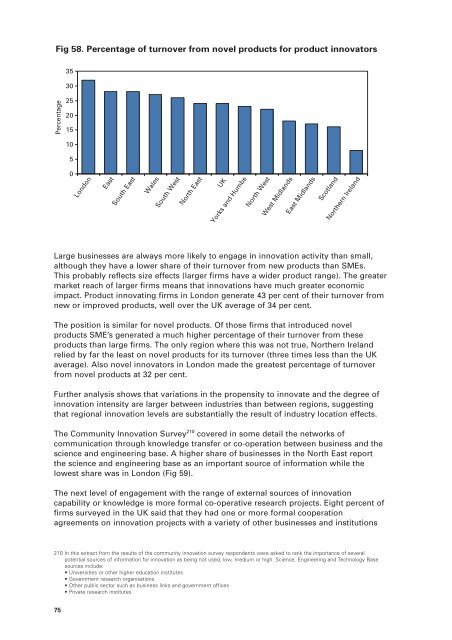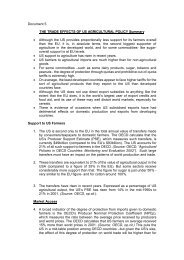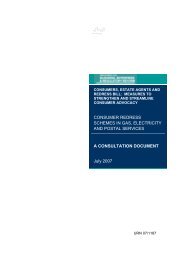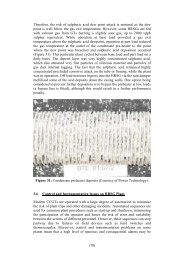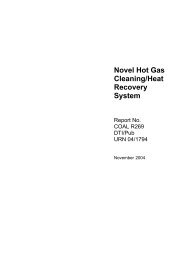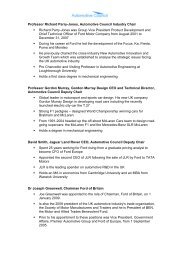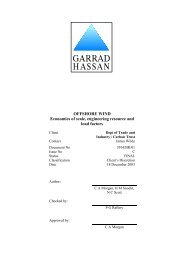Competing in the Global Economy – The Innovation Challenge
Competing in the Global Economy – The Innovation Challenge
Competing in the Global Economy – The Innovation Challenge
You also want an ePaper? Increase the reach of your titles
YUMPU automatically turns print PDFs into web optimized ePapers that Google loves.
Fig 58. Percentage of turnover from novel products for product <strong>in</strong>novators<br />
Percentage<br />
Large bus<strong>in</strong>esses are always more likely to engage <strong>in</strong> <strong>in</strong>novation activity than small,<br />
although <strong>the</strong>y have a lower share of <strong>the</strong>ir turnover from new products than SMEs.<br />
This probably reflects size effects (larger firms have a wider product range). <strong>The</strong> greater<br />
market reach of larger firms means that <strong>in</strong>novations have much greater economic<br />
impact. Product <strong>in</strong>novat<strong>in</strong>g firms <strong>in</strong> London generate 43 per cent of <strong>the</strong>ir turnover from<br />
new or improved products, well over <strong>the</strong> UK average of 34 per cent.<br />
<strong>The</strong> position is similar for novel products. Of those firms that <strong>in</strong>troduced novel<br />
products SME’s generated a much higher percentage of <strong>the</strong>ir turnover from <strong>the</strong>se<br />
products than large firms. <strong>The</strong> only region where this was not true, Nor<strong>the</strong>rn Ireland<br />
relied by far <strong>the</strong> least on novel products for its turnover (three times less than <strong>the</strong> UK<br />
average). Also novel <strong>in</strong>novators <strong>in</strong> London made <strong>the</strong> greatest percentage of turnover<br />
from novel products at 32 per cent.<br />
Fur<strong>the</strong>r analysis shows that variations <strong>in</strong> <strong>the</strong> propensity to <strong>in</strong>novate and <strong>the</strong> degree of<br />
<strong>in</strong>novation <strong>in</strong>tensity are larger between <strong>in</strong>dustries than between regions, suggest<strong>in</strong>g<br />
that regional <strong>in</strong>novation levels are substantially <strong>the</strong> result of <strong>in</strong>dustry location effects.<br />
<strong>The</strong> Community <strong>Innovation</strong> Survey 210 covered <strong>in</strong> some detail <strong>the</strong> networks of<br />
communication through knowledge transfer or co-operation between bus<strong>in</strong>ess and <strong>the</strong><br />
science and eng<strong>in</strong>eer<strong>in</strong>g base. A higher share of bus<strong>in</strong>esses <strong>in</strong> <strong>the</strong> North East report<br />
<strong>the</strong> science and eng<strong>in</strong>eer<strong>in</strong>g base as an important source of <strong>in</strong>formation while <strong>the</strong><br />
lowest share was <strong>in</strong> London (Fig 59).<br />
<strong>The</strong> next level of engagement with <strong>the</strong> range of external sources of <strong>in</strong>novation<br />
capability or knowledge is more formal co-operative research projects. Eight percent of<br />
firms surveyed <strong>in</strong> <strong>the</strong> UK said that <strong>the</strong>y had one or more formal cooperation<br />
agreements on <strong>in</strong>novation projects with a variety of o<strong>the</strong>r bus<strong>in</strong>esses and <strong>in</strong>stitutions<br />
210 In this extract from <strong>the</strong> results of <strong>the</strong> community <strong>in</strong>novation survey respondents were asked to rank <strong>the</strong> importance of several<br />
potential sources of <strong>in</strong>formation for <strong>in</strong>novation as be<strong>in</strong>g not used, low, medium or high. Science, Eng<strong>in</strong>eer<strong>in</strong>g and Technology Base<br />
sources <strong>in</strong>clude:<br />
• Universities or o<strong>the</strong>r higher education <strong>in</strong>stitutes<br />
• Government research organisations<br />
• O<strong>the</strong>r public sector such as bus<strong>in</strong>ess l<strong>in</strong>ks and government offices<br />
• Private research <strong>in</strong>stitutes<br />
75<br />
35<br />
30<br />
25<br />
20<br />
15<br />
10<br />
5<br />
0<br />
London<br />
East<br />
South East<br />
Wales<br />
South West<br />
North East<br />
UK<br />
Yorks and Humbs<br />
North West<br />
West Midlands<br />
East Midlands<br />
Scotland<br />
Nor<strong>the</strong>rn Ireland


